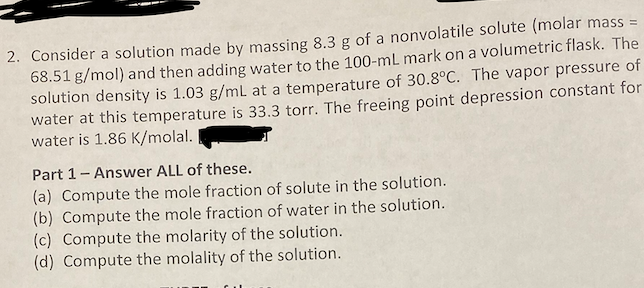Consider a solution made by massing 8.3 g of a nonvolatile solute (molar mass = 68.51 g/mol) and then adding water to the 100-mL mark on a volumetric flask. The solution density is 1.03 g/mL at a temperature of 30.8°C. The vapor pressure o water at this temperature is 33.3 torr. The freeing point depression constant fo water is 1.86 K/molal. Part 1- Answer ALL of these. (a) Compute the mole fraction of solute in the solution. (b) Compute the mole fraction of water in the solution. (c) Compute the molarity of the solution. (d) Compute the molality of the solution.
Consider a solution made by massing 8.3 g of a nonvolatile solute (molar mass = 68.51 g/mol) and then adding water to the 100-mL mark on a volumetric flask. The solution density is 1.03 g/mL at a temperature of 30.8°C. The vapor pressure o water at this temperature is 33.3 torr. The freeing point depression constant fo water is 1.86 K/molal. Part 1- Answer ALL of these. (a) Compute the mole fraction of solute in the solution. (b) Compute the mole fraction of water in the solution. (c) Compute the molarity of the solution. (d) Compute the molality of the solution.
Chemistry: Principles and Reactions
8th Edition
ISBN:9781305079373
Author:William L. Masterton, Cecile N. Hurley
Publisher:William L. Masterton, Cecile N. Hurley
Chapter10: Solutions
Section: Chapter Questions
Problem 77QAP: Consider 2 vapor pressure curves A and B. They are the vapor pressure curves of pure benzene and a...
Related questions
Question
100%

Transcribed Image Text:2. Consider a solution made by massing 8.3 g of a nonvolatile solute (molar mass =
68.51 g/mol) and then adding water to the 100-mL mark on a volumetric flask. The
solution density is 1.03 g/mL at a temperature of 30.8°C. The vapor pressure of
water at this temperature is 33.3 torr. The freeing point depression constant for
water is 1.86 K/molal.
Part 1- Answer ALL of these.
(a) Compute the mole fraction of solute in the solution.
(b) Compute the mole fraction of water in the solution.
(c) Compute the molarity of the solution.
(d) Compute the molality of the solution.
Expert Solution
This question has been solved!
Explore an expertly crafted, step-by-step solution for a thorough understanding of key concepts.
Step by step
Solved in 2 steps with 2 images

Knowledge Booster
Learn more about
Need a deep-dive on the concept behind this application? Look no further. Learn more about this topic, chemistry and related others by exploring similar questions and additional content below.Recommended textbooks for you

Chemistry: Principles and Reactions
Chemistry
ISBN:
9781305079373
Author:
William L. Masterton, Cecile N. Hurley
Publisher:
Cengage Learning

Chemistry: An Atoms First Approach
Chemistry
ISBN:
9781305079243
Author:
Steven S. Zumdahl, Susan A. Zumdahl
Publisher:
Cengage Learning


Chemistry: Principles and Reactions
Chemistry
ISBN:
9781305079373
Author:
William L. Masterton, Cecile N. Hurley
Publisher:
Cengage Learning

Chemistry: An Atoms First Approach
Chemistry
ISBN:
9781305079243
Author:
Steven S. Zumdahl, Susan A. Zumdahl
Publisher:
Cengage Learning


Chemistry
Chemistry
ISBN:
9781305957404
Author:
Steven S. Zumdahl, Susan A. Zumdahl, Donald J. DeCoste
Publisher:
Cengage Learning

Chemistry: Principles and Practice
Chemistry
ISBN:
9780534420123
Author:
Daniel L. Reger, Scott R. Goode, David W. Ball, Edward Mercer
Publisher:
Cengage Learning

Principles of Modern Chemistry
Chemistry
ISBN:
9781305079113
Author:
David W. Oxtoby, H. Pat Gillis, Laurie J. Butler
Publisher:
Cengage Learning